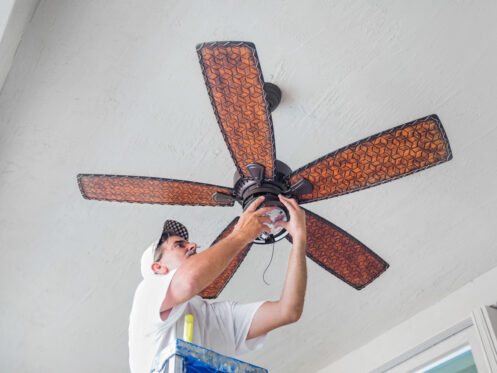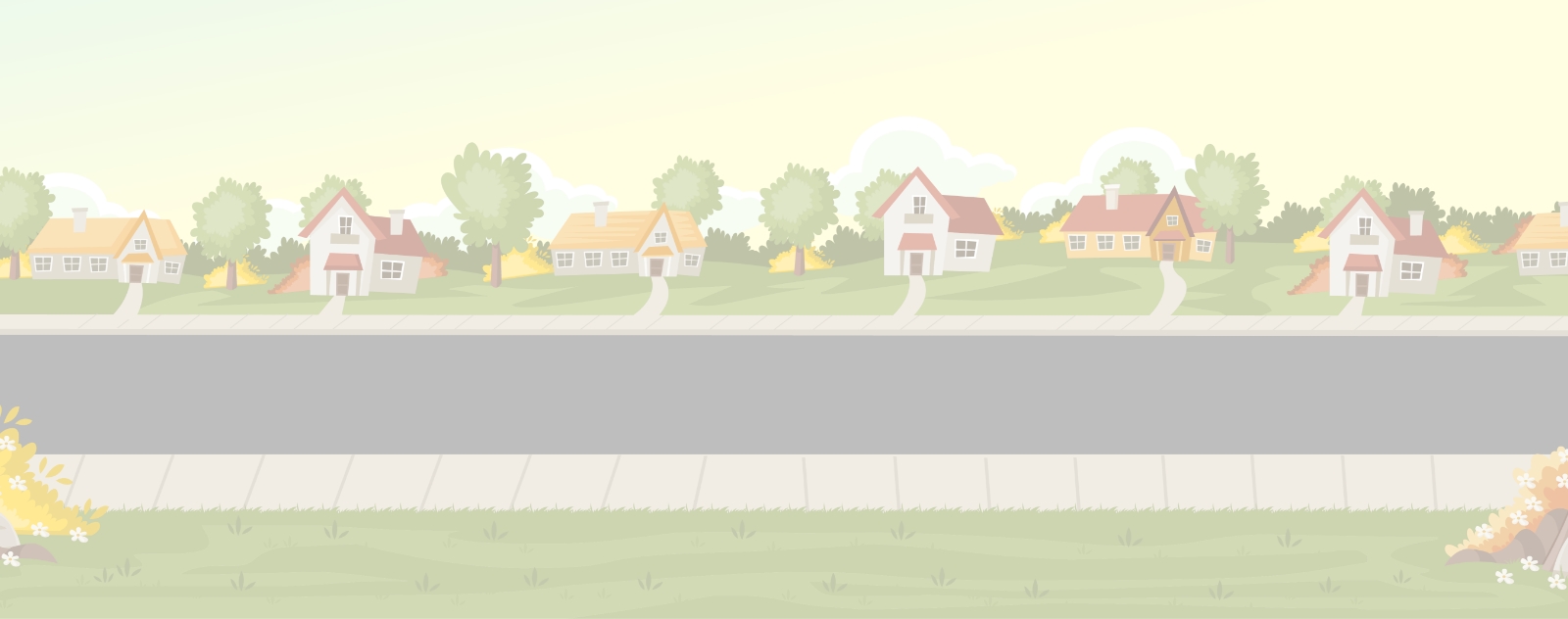Air circulation has a direct impact on a home’s comfort levels. Proper airflow is crucial to regulating the indoor temperature, which plays a significant role in avoiding hot and cold spots. It also disperses airborne pollutants, making the home’s indoor air healthier to breathe. To maintain proper airflow, a home must have adequate ventilation. The consistent air movement provided by adequate ventilation minimizes stuffiness and odors, creating a fresher living environment. Proper air circulation also improves the home’s energy efficiency, making it easier for the heating and cooling systems to keep the home at your preferred temperature. One of the easiest ways to improve a home’s air circulation is by installing and using ceiling fans.
How to Install a Ceiling Fan
When an electrcian installs ceiling fans, they begin by assessing the room for an optimal fan location and checking the ceiling support. After turning off power, they mount the fan bracket, connect wires and secure the fan in place. Then, they ensure proper balancing and attachment of fan blades to the motor, followed by assembling any additional components, such as light kits or remote controls. After installation, they test the fan for functionality. Precise execution of these steps is crucial for safe and efficient ceiling fan operation. Technicians may also provide advice on fan speed settings and proper maintenance for optimal performance.
Reasons to Let a Professional Do the Installation
There are a number of advantages to having a professional handle the installation of your ceiling fan. To start, they are experts at finding the best spot and making sure the ceiling is sturdy enough. They are well-versed in electrical wiring, so you can be certain that they will make precise connections. Skilled technicians can expertly install any supplementary parts, such as light kits or remote controllers, without a hitch. Their extensive testing and expertise in balancing fan blades ensure peak performance. Experts not only know their stuff, but they also help you save time, provide you with warranties and give you great advice on how to set up and maintain your fans. If you want your ceiling fan to work safely, efficiently, and without any problems, it’s best to have a professional install it.
Best Ways to Use a Ceiling Fan to Improve Indoor Comfort
Ceiling fans offer versatile ways to enhance indoor comfort. In warmer months, running the fan in a counterclockwise direction creates a cooling breeze, providing a perceived drop in temperature and allowing you to set the thermostat to a higher temperature, which saves on energy bills. Conversely, in colder seasons, reversing the fan’s direction circulates warm air trapped near the ceiling down to occupied spaces, improving heating efficiency. Properly positioned ceiling fans also contribute to more even air distribution, eliminating hot and cold spots in a room.
Moreover, ceiling fans support ventilation by promoting air movement and reducing the stagnation of indoor air. Combining fan use with open windows enhances natural ventilation, minimizing reliance on mechanical cooling systems. Ceiling fans with integrated light fixtures offer dual functionality, providing both illumination and air circulation, contributing to an overall well-lit and comfortable living space. Regular maintenance, including cleaning fan blades and balancing, ensures optimal performance. This makes ceiling fans an energy-efficient and effective solution for year-round comfort.
Other Ways to Improve Indoor Comfort
In addition to using ceiling fans, there are lots of other ways to improve indoor comfort. You can use the tips below to make your home more energy-efficient and comfortable at the same time.
Optimal Temperature Control
It takes a mix of prudent measures to guarantee that a home’s temperature is always just right. Get things rolling by changing the thermostat to a cozy temperature that suits you, taking into account any seasonal variations. To control the amount of light coming in and the amount of heat going out, use shades or curtains together with insulation. To promote more uniform temperatures, use ceiling fans to increase air circulation. The optimal running of your HVAC system depends on regular maintenance, which includes replacing the air filter. For personalized temperature regimens, programmable thermostats are a great investment. Finally, fix any drafts or air leaks so the inside environment stays the same.
Proper Humidity Levels
Humidifiers and dehumidifiers are versatile tools for indoor comfort. In dry conditions, humidifiers add moisture to the air, preventing dry skin and respiratory discomfort. During humid seasons, dehumidifiers remove excess moisture, preventing mold growth and creating a more comfortable atmosphere. Both devices contribute to maintaining ideal humidity levels and enhancing overall comfort. They both also allow you to quickly address specific climate needs, whether in wintertime dryness or hot and humid summers.
Good Air Circulation
Improving indoor air circulation involves several strategies. Ensure proper ventilation by opening windows regularly to let fresh air in and stale air out. Use portable fans strategically to enhance airflow in specific areas. Arrange furniture to allow unobstructed airflow and avoid blocking vents. Use exhaust fans in kitchens and bathrooms to remove pollutants. Additionally, keeping interior doors open allows air to move freely throughout the home. These measures promote consistent air circulation, reduce stuffiness and contribute to better indoor air quality and overall comfort.
Comfortable Furniture
Opt for ergonomic chairs and sofas that provide adequate support, enhancing overall well-being. Consider soft, comfortable cushions and upholstery for a cozy feel. Multi-functional furniture, like sleeper sofas or storage ottomans, maximizes utility. Select pieces that suit the room’s layout, promoting easy movement and creating a visually appealing and comfortable living space. Ultimately, thoughtful furniture choices contribute to a welcoming and comfortable home environment.
Quality Bedding
Creating a cozy and welcoming bedroom with well-selected bedding can greatly improve your sleep quality and general health. For a good night’s sleep, invest in a high-quality mattress that fits your tastes. For a homier vibe, go for bedding made of breathable and warm materials like linen or cotton. Pillows come in different degrees of firmness to accommodate different sleeping patterns and demands. Duvets and blankets add even more coziness and warmth.
Effective Insulation
Proper insulation regulates temperatures by minimizing heat transfer and preventing drafts and temperature extremes. In colder weather, it retains warmth, and in hot weather, it impedes heat infiltration, creating a more stable climate. Well-insulated homes require less energy for heating and cooling, enhancing energy efficiency. Adequate insulation also reduces noise transmission, contributing to a quieter and more comfortable living environment overall. It’s a fundamental component for achieving optimal indoor comfort and energy savings.
HVAC Maintenance
During AC and furnace tune-ups, technicians perform various tasks to enhance indoor comfort. They clean and inspect components, ensuring efficient operation. Checking and adjusting thermostat settings optimizes temperature control. Lubricating moving parts reduces friction and noise. Filter replacement or cleaning improves air quality. Inspection of ductwork prevents air leaks. The calibration of safety controls ensures system reliability. Detecting and addressing potential issues prevents breakdowns, promoting uninterrupted comfort.
Are you looking for ways to improve your home’s indoor comfort? If so, give Spark Daddy a call today. We help Sullivan homeowners install ceiling fans in addition to offering a wide variety of heating, cooling and electrical services. We can even help you improve your home’s ventilation and air circulation. Contact Spark Daddy now to schedule HVAC maintenance or a ceiling fan installation.




